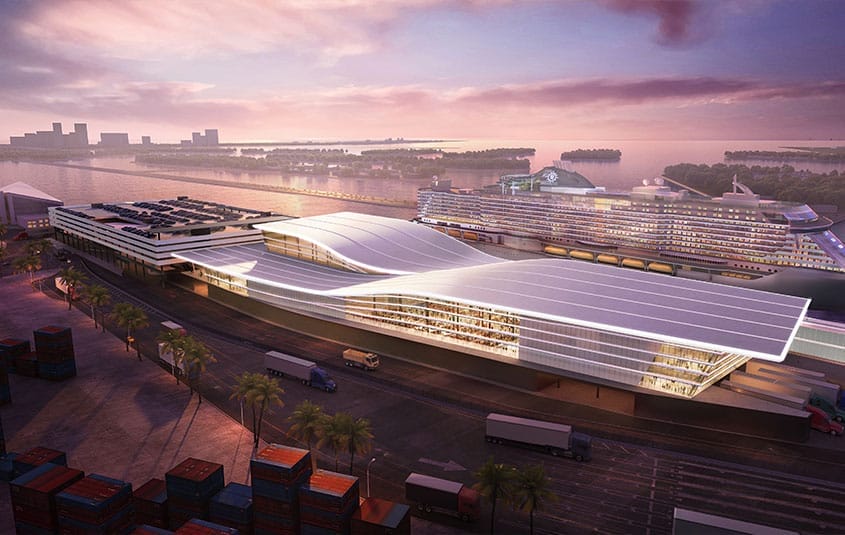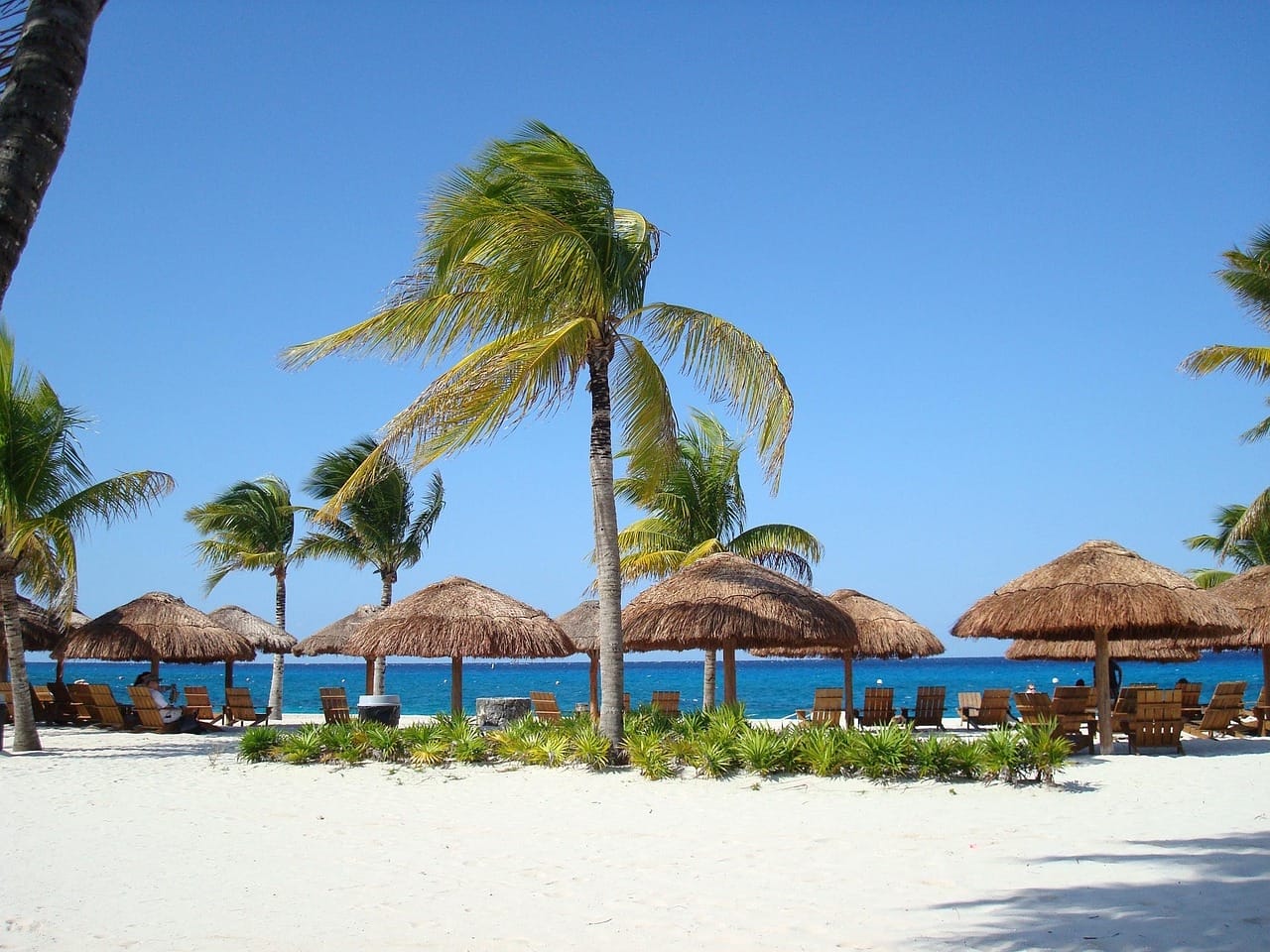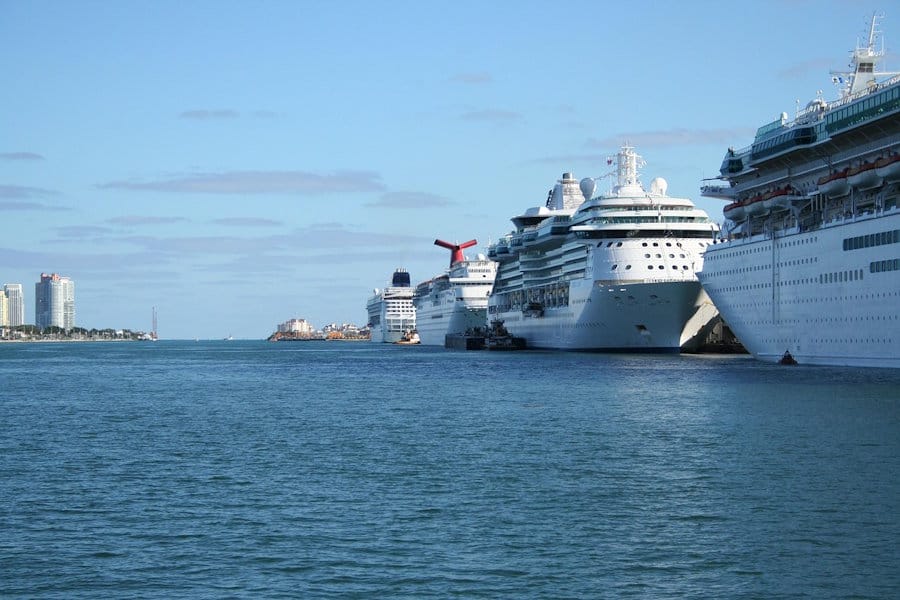The cruise industry celebrated a historic milestone with the opening of the MSC Miami Cruise Terminal at PortMiami, Florida. Officially named Terminal AA/AAA, this 492,678-square-foot facility is the largest and most advanced cruise terminal in the world, capable of processing up to 36,000 passengers daily.
Designed by Miami-based Arquitectonica and constructed by Fincantieri Infrastructure at a cost of $450 million, the terminal is a cornerstone of MSC Cruises’ ambitious expansion in the North American market.
Let’s take a deeper look at the terminal’s design, technology, sustainability efforts, and economic impact, while also examining MSC’s newest ships, the significance of the U.S. market, and a detailed comparison with other major cruise terminals at PortMiami, including those operated by Royal Caribbean, Virgin Voyages, Carnival, and Norwegian Cruise Line.
Please note that any and all pricing is subject to change and reflects rates current as of this writing, April 2025.
Table of Contents
ToggleA New Era in Cruise Infrastructure
The MSC Miami Cruise Terminal is a four-story architectural marvel that spans nearly half a million square feet, equivalent to about 8.5 American football fields. Its ship-inspired design, with sleek lines and a facade resembling a modern cruise liner, integrates seamlessly with Miami’s iconic skyline.
Currently, the terminal can accommodate two cruise ships simultaneously, with plans for a third berth by 2028, ensuring scalability to handle the growing size and volume of cruise vessels. It serves as the homeport for MSC Cruises’ flagship MSC World America and supports luxury vessels from MSC’s Explora Journeys brand, such as Explora I.
The terminal’s development reflects a $450 million investment by MSC Cruises, in partnership with PortMiami and Miami-Dade County. This collaboration underscores Miami’s status as the world’s busiest cruise port, handling over 6.8 million passengers annually.
The terminal’s opening, timed with the 2025 Seatrade Cruise Global conference, showcased its capabilities to 12,000 industry professionals, cementing PortMiami’s role as the global epicenter of cruising.
Cutting-Edge Technology for Passenger Efficiency
The MSC Miami Cruise Terminal sets a new standard for passenger processing with its fully biometric journey, a first in the cruise industry. Passengers can complete embarkation using facial recognition and digital identity verification through 18 biometric face pods and 22 E-gates, reducing wait times to minutes.
The MSC for Me app and website allow guests to check in online, upload documents, and receive digital boarding passes, further streamlining the process.
The terminal’s baggage handling system, featuring 42 baggage screening machines and cross-belt technology akin to airport systems, ensures efficient luggage processing.
A 10,816-square-foot digital projection display on the exterior, powered by Gauzy’s smart glass technology, uses real-time NOAA ocean data to create dynamic visuals of tides, currents, and weather patterns, enhancing the terminal’s aesthetic and technological appeal.
With a six-level parking garage offering over 2,400 spaces, the terminal is equipped to handle high volumes of passengers with ease.
Design and Cultural Significance
Designed by Arquitectonica, the terminal’s architecture blends functionality with elegance. Its ship-like silhouette, flooded with natural light and offering panoramic Caribbean views, creates an inviting atmosphere.
The interior features an airport-style layout with intuitive guest flow, ensuring efficiency even during peak times. Seven curated artworks, part of the Miami-Dade County Art in Public Places program, transform the terminal into a cultural hub, with exclusive pieces in the MSC Yacht Club lounge adding a touch of luxury.
The terminal’s design prioritizes guest comfort, with spacious waiting areas, dining options, and retail spaces. Its strategic location on Dodge Island ensures it is the last terminal seen by departing ships and the first by returning ones, making it a visual landmark for PortMiami.
Sustainability and Environmental Responsibility
Sustainability is integral to the MSC Miami Cruise Terminal’s operations. The facility is equipped with shore power capabilities, provided by Florida Power & Light, allowing docked ships to switch off engines and reduce emissions.
This feature supports MSC’s LNG-powered vessels, such as MSC World America, which use cleaner fuel to minimize environmental impact. The terminal’s smart glass facade optimizes natural light, reducing energy consumption, and its construction incorporates sustainable materials, aligning with Leadership in Energy and Environmental Design (LEED) Gold certification goals.
These efforts reflect MSC Cruises’ commitment to environmental stewardship, particularly in Miami’s ecologically sensitive region. The terminal’s sustainability initiatives set a benchmark for future cruise infrastructure, balancing growth with conservation.
MSC’s Newest Ships: Pioneering the U.S. Market
MSC Cruises has significantly expanded its North American presence, with the U.S. being a critical market for growth. The company’s newest ships, MSC World America and MSC Seascape, are tailored to appeal to American cruisers while maintaining MSC’s European flair.
MSC World America
Launched on April 9, 2025, MSC World America is MSC’s largest ship, with a capacity of 6,762 passengers across 22 decks. As the second vessel in the World Class series, it features seven onboard districts, including a family zone, an adults-only Zen area, and the largest MSC Yacht Club in the Caribbean.
The ship offers 19 dining venues, such as Eataly at Sea and Paxos for Greek cuisine, alongside 18 bars, an outdoor water park, a ropes course, and the unique Cliffhanger overwater swing ride.
Powered by LNG, it aligns with the terminal’s sustainability goals and sails year-round from Miami to Eastern and Western Caribbean itineraries, including stops at Ocean Cay MSC Marine Reserve.
MSC Seascape
Introduced in 2022, MSC Seascape is a high-tech ship with a capacity of 5,632 passengers. It features modern accommodations, diverse dining options, and immersive entertainment, including a robotron thrill ride and virtual reality experiences.
Departing from Miami and Galveston, Texas, MSC Seascape offers Caribbean itineraries with stops at Ocean Cay, catering to U.S. cruisers seeking value-driven vacations.
U.S. Market Significance
The U.S. represents a massive opportunity for MSC Cruises, with North American cruise passenger volume rising steadily every year.
MSC’s strategic focus on the U.S. includes deploying its newest ships to Miami, building the world’s largest cruise terminal, and investing $100 million in a new U.S. headquarters for Mediterranean Shipping Group in downtown Miami. According to MSC Cruises USA Chairman Rick Sasso, the company’s “Five Vs” strategy—Volume, Value, Voice, Variety, and Vision—has driven its rapid growth. Since bringing its first ship to North America in 2019, MSC has expanded to 23 ships, with two more World Class vessels planned for 2026 and 2027.
MSC’s value-driven pricing is a key differentiator. For example, a 7-night cruise on MSC World America in September 2026 starts at $905 per person for an interior stateroom. A Wi-Fi and a drink package adds $392, totaling $1,297.
In contrast, a similar cruise on Royal Caribbean’s Star of the Seas starts at $1,545, with add-ons pushing costs above $1,700. This affordability, combined with modern amenities, positions MSC as a strong competitor in the U.S. market.
Comparison of Major Miami Cruise Terminals
PortMiami hosts several state-of-the-art terminals operated by leading cruise lines, each with unique features and capacities. Below is a detailed comparison of the MSC Miami Cruise Terminal with those of Royal Caribbean, Virgin Voyages, Carnival, and Norwegian Cruise Line.
Royal Caribbean: Terminal A (The Crown of Miami)
- Size and Capacity: Opened in 2018, Terminal A is 170,000 square feet and can handle 2 million passengers annually, accommodating Oasis-class ships like Wonder of the Seas (6,988 passengers). It processes up to 10,000 passengers daily, significantly less than MSC’s 36,000.
- Design and Technology: Designed by Broadway Malyan, the terminal’s angular glass structure resembles a high-tech ship. It features expedited security check-ins and spacious waiting areas but lacks MSC’s biometric journey. Its parking garage accommodates 1,000 vehicles.
- Sustainability: LEED Silver certified, with shore power capabilities completed in 2024. However, it supports fewer berths (one) compared to MSC’s two (soon three).
- Unique Features: Known for its glowing nighttime facade, Terminal A is efficient but smaller in scale, focusing on Royal Caribbean’s mega-ships rather than multi-ship operations.
- Comparison: While Terminal A was the largest in the U.S. until 2025, MSC’s terminal surpasses it in size, capacity, and technological innovation, particularly with biometrics and multi-ship docking.
Virgin Voyages: Terminal V
Scarlet Lady
- Size and Capacity: Opened in 2022, Terminal V is 100,000 square feet and designed for smaller, luxury vessels like Scarlet Lady (2,770 passengers). It processes up to 5,000 passengers daily, a fraction of MSC’s capacity.
- Design and Technology: Arquitectonica’s palm grove-inspired design evokes a tropical oasis. The terminal features digital check-in but lacks biometric systems. Its boutique layout caters to Virgin’s adults-only, premium experience.
- Sustainability: LEED Silver certified, with shore power capabilities. Its smaller scale limits environmental impact but also its operational scope.
- Unique Features: Terminal V’s geometric design and palm canopy roof create a vacation-like atmosphere. It’s tailored for luxury and exclusivity, unlike MSC’s mass-market focus.
- Comparison: Terminal V prioritizes aesthetics and niche appeal over scale, making it less versatile than MSC’s terminal, which handles significantly larger volumes and multiple ship types.
Carnival Cruise Line: Terminals D, E, and F
- Size and Capacity: Terminals D and E (expanded in 2018) and Terminal F (renovated in 2022) collectively span 471,000 square feet, close to MSC’s size. They accommodate Excel-class ships like Mardi Gras (6,631 passengers) and process up to 20,000 passengers daily across three berths.
- Design and Technology: Designed for efficiency, the terminals feature facial recognition for security but not a fully biometric journey. Terminal F’s renovation included telescopic boarding bridges for larger ships. Parking is extensive but not centralized like MSC’s garage.
- Sustainability: LEED Silver certified, with shore power installed in 2024. Carnival’s focus on larger ships aligns with MSC’s, but its terminals are older and less integrated.
- Unique Features: Terminal F’s sweeping design and Carnival’s brand-colored lighting are visually striking. The terminals support Carnival’s high-volume operations but lack MSC’s digital art and cultural elements.
- Comparison: Carnival’s terminals rival MSC’s in size and berth capacity but lag in technological innovation and aesthetic appeal. MSC’s unified, modern design and biometric systems give it an edge.
Norwegian Cruise Line: Terminal B (The Pearl of Miami)
- Size and Capacity: Opened in 2020, Terminal B is 190,000 square feet and handles ships like Norwegian Encore (4,004 passengers), processing up to 10,000 passengers daily. It supports one berth, limiting its scale compared to MSC.
- Design and Technology: Designed by Bermello Ajamil & Partners, the terminal’s wave-like facade is striking. It features digital check-in and streamlined embarkation but lacks MSC’s biometric capabilities.
- Sustainability: LEED Silver certified, with shore power capabilities. Its smaller footprint reduces environmental impact but limits multi-ship operations.
- Unique Features: The nautilus-inspired design is a visual standout, but the terminal’s focus on Norwegian’s mid-sized ships makes it less versatile than MSC’s.
- Comparison: Terminal B is modern and efficient but significantly smaller and less technologically advanced than MSC’s terminal, which excels in capacity and innovation.
Summary of Comparison
The MSC Miami Cruise Terminal outshines its competitors in size, passenger capacity, and technological innovation, particularly with its biometric journey and multi-ship docking capabilities.
While Royal Caribbean’s Terminal A and Carnival’s Terminals D, E, and F handle large ships, they process fewer passengers daily and lack MSC’s advanced systems.
Virgin Voyages’ Terminal V and Norwegian’s Terminal B prioritize aesthetics and niche markets but cannot match MSC’s scale or versatility. MSC’s terminal is uniquely positioned to handle the cruise industry’s largest ships and highest passenger volumes, setting a new global standard.
Economic and Tourism Impact
The MSC Miami Cruise Terminal is a catalyst for Miami’s economy, reinforcing PortMiami’s status as the world’s busiest cruise port. The terminal is expected to attract millions of passengers annually, boosting tourism-related sectors like hospitality, transportation, and retail.
MSC’s $100 million investment in a new U.S. headquarters further solidifies its commitment to the region, creating jobs and economic opportunities.
The terminal supports four MSC Cruises ships and Explora Journeys vessels in 2025, driving consistent passenger traffic. Its ability to process high volumes efficiently makes Miami a preferred embarkation point for Caribbean cruises, attracting international travelers.
The terminal’s prominence during the 2025 Seatrade Cruise Global conference highlighted its role in elevating Miami’s global tourism profile.
Guest Experience: A Seamless Journey
Passengers at the MSC Miami Cruise Terminal enjoy a modern, efficient experience. The terminal’s intuitive layout, biometric check-ins, and digital tools minimize wait times, even during peak periods.
Guests can explore curated art installations, relax in the MSC Yacht Club lounge, or shop and dine in spacious retail and dining areas. The six-level parking garage, dedicated bus and ride-share zones, and proximity to Miami International Airport (20 minutes) and Fort Lauderdale-Hollywood International Airport (35 minutes) ensure accessibility.
Looking Ahead
The MSC Miami Cruise Terminal is a transformative force in the cruise industry, blending scale, technology, and sustainability. Its influence extends beyond Miami, inspiring global ports to adopt similar innovations.
As MSC Cruises continues to expand its U.S. presence with new ships and infrastructure, the terminal will remain a cornerstone of its strategy, supporting the growing demand for Caribbean cruises.
For travelers, the terminal offers a seamless and memorable start to their journey, combining efficiency with elegance. For Miami, it reinforces the city’s status as the cruise capital of the world, driving economic growth and tourism.
Whether you’re embarking on MSC World America or another MSC vessel, the MSC Miami Cruise Terminal promises an unparalleled experience from the moment you arrive.
Get ready to set sail!
The MSC Miami Cruise Terminal has redefined cruise infrastructure with its massive scale, cutting-edge technology, and commitment to sustainability. As the homeport for MSC World America and a hub for MSC’s U.S. expansion, it positions MSC Cruises as a major player in the North American market, challenging competitors like Royal Caribbean and Carnival.
Compared to other PortMiami terminals, MSC’s facility stands out for its capacity, innovation, and cultural appeal, setting a new benchmark for the industry. For cruisers, it’s not just a terminal—it’s the gateway to an unforgettable adventure.
This page contains affiliate links for which we may receive financial compensation when a purchase has been made through one of our affiliate partners.








